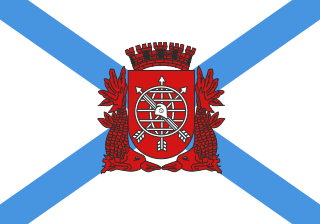
Corcovado which means "hunchback" in Portuguese, is a mountain in central Rio de Janeiro, Brazil. It is a 710-metre (2,330-foot) granite peak located in the Tijuca Forest, a national park.

The Tijuca National Park is an urban national park in the mountains of the city of Rio de Janeiro, Brazil. The park is part of the Atlantic Forest Biosphere Preserve, and is administered by the Chico Mendes Institute for Biodiversity Conservation (ICMBio).

Flamengo is a neighborhood in Rio de Janeiro, Brazil.

Christ the Redeemer is an Art Deco statue of Jesus in Rio de Janeiro, Brazil, created by French-Polish sculptor Paul Landowski and built by Brazilian engineer Heitor da Silva Costa, in collaboration with French engineer Albert Caquot. Romanian sculptor Gheorghe Leonida sculpted the face. Constructed between 1922 and 1931, the statue is 30 metres (98 ft) high, excluding its 8-metre (26 ft) pedestal. The arms stretch 28 metres (92 ft) wide. It is made of reinforced concrete and soapstone. Christ The Redeemer differs considerably from its original design, as the initial plan was a large Christ with a globe in one hand and a cross in the other. Although the project organizers originally accepted the design, it later changed to the statue of today, with the arms spread out wide.
Escola Americana do Rio de Janeiro is a non-profit twin-campus IB World Continuum school located in Rio de Janeiro, Brazil. The school was founded in 1937 as a private, independent, coeducational, non-denominational day school. EARJ offers an educational program from Nursery through Grade 12 for students of all nationalities. In 2023-24, enrollment was 1,352 students across the Gávea and Barra campuses with 236 members of teaching faculty.

The Rio de Janeiro Botanical Garden or Jardim Botânico is located at the Jardim Botânico district in the South Zone of Rio de Janeiro.
Brígida Baltar was a Brazilian visual artist. Her work spanned across a wide range of mediums, including video, performance, installation, drawing, and sculpture. She was interested in capturing the ephemeral in her artwork.

The School of Visual Arts is a school for artists, curators, researchers and others in Rio de Janeiro. It is located within the Rio de Janeiro Botanical Garden.
Jorge Glusberg was an Argentine author, publisher, curator, professor, and conceptual artist.
The following is a timeline of the history of the city of Rio de Janeiro, Brazil.
Leda Catunda Serra, known as Leda Catunda is a Brazilian painter, sculptor, graphic artist and educator. She is a representative name of the Geração 80 artists' group. Her works explore the limits of textures and materials, being characterized by her "soft paintings" over towels, bedclothes, leather, velvet and silk.

Edith Behring was a Brazilian artist and educator.

The following outline is provided as an overview of and topical guide to Rio de Janeiro:

Lucio Salvatore is an Italian-born multidisciplinary Brazilian artist who works with sculpture, photography, text, painting, performance and appropriation of processes. Salvatore lives and works in Rio de Janeiro and in Sant’Elia Fiumerapido, Italy. Salvatore’s artworks are situations created with heterogeneous elements, processes and people that work together in experimental form. His work is seen as a critique of both centralized and decentralized powers and its abuses, social control and consumerism in its broadest declination, especially cultural.
Celeida Tostes (May 26, 1929 in Rio de Janeiro – January 3, 1995 in Rio de Janeiro was a Brazilian female drawing teacher and artist, specifically a sculptor and ceramist, that focused on Postwar and Contemporary Art.
Martha Araújo in Maceió, Brazil is a Brazilian sculptor and performance artist. She lives and works in Maceió the capital of Alagoas in Brazil. The style of her work was performance and sculpture art. She also explored her body with her performances. Her art emerged at the end of a military dictatorship that lasted from 1964 to 1985. She used their experiences during the dictatorship in her artwork to show how they felt trapped. Using textiles Araújo demonstrates the limit of the body through the play between repression and freedom. However, sculptures and performances were not her only interest she has also explored photography and video.
Neide Dias de Sá is a Brazilian artist who spent a big portion of her life teaching children art starting in the 1960s. Together with three others, she began an art movement in 1967 known as Poema/Processo. This art movement questioned the restraints that came with using words and replaced words with pictures. She did this years before pursuing a formal education in art. She did not earn her degree in graphic design until 1980.
Maria Nepomuceno (1976) is a Brazilian artist from Rio de Janeiro. Nepomuceno is a contemporary sculptor and installation artist who's known for her knitted sculptural works. Her artistic practice is based upon traditional weaving techniques that are rooted in her Brazilian cultural upbringing. Drawing inspirations from indigenous traditions, Afro-Brazilian spirituality, and Brazilian landscapes. Her art explores the themes of identity and spirituality, reflecting on her own experiences as a Brazilian Woman of mixed heritage. Nepomuceno's work intersects artistic and social movements, such as feminist art, Neo-Concrete and environmental activism. Her work resembles classic contemporary art movements such as Surrealism and Abstract Expressionism through her exploration of themes deeply rooted in the subconscious and spiritual which create sculptures that appear to grow naturally.
Nelson Leirner was a Brazilian artist. Leirner has participated in several exhibitions in Brazil and abroad. In 1997, he moved to Rio de Janeiro and began teaching at the Escola de Artes Visuais do Parque Lage. He lives and works in Rio de Janeiro.

Angelo Venosa was a Brazilian sculptor.










